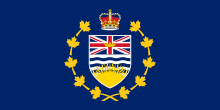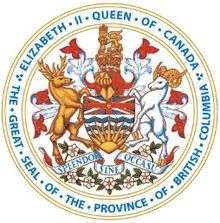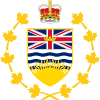Lieutenant Governor of British Columbia
| Lieutenant Governor of British Columbia | |
|---|---|
|
Emblem of the Lieutenant Governor | |
| Viceroy | |
| Style | Her Honour the Honourable |
| Residence | Government House, Victoria |
| Appointer | Governor General of Canada |
| Term length | At the Governor General's pleasure |
| Formation | 20 July 1871 |
| First holder | Joseph Trutch |
| Website | www.ltgov.bc.ca |

The Lieutenant-Governor of British Columbia /lɛfˈtɛnənt/ is the viceregal representative in British Columbia of the Canadian monarch, Queen Elizabeth II, who operates distinctly within the province but is also shared equally with the ten other jurisdictions of Canada, as well as the other Commonwealth realms and any subdivisions thereof, and resides predominantly in her oldest realm, the United Kingdom. The Lieutenant Governor of British Columbia is appointed in the same manner as the other provincial viceroys in Canada and is similarly tasked with carrying out most of the monarch's constitutional and ceremonial duties.[1] The present, and 29th, Lieutenant Governor of British Columbia is Judith Guichon, who has served in the role since 2 November 2012.
Role and presence
The Lieutenant-Governor of British Columbia is vested with a number of governmental duties. One such task unique to the Lieutenant-Governor of British Columbia is authenticating with the Great Seal of British Columbia notarized documents to be used outside of the province. However, the issuance of a Certificate of Authentication only means the signature of the notary public matched the ones on file and not the authenticity or truthfulness of the texts themselves.[2] As Canada is not a signatory state to the Hague Convention Abolishing the Requirement of Legalisation for Foreign Public Documents, this procedure is simply called authentication instead of apostille.
The viceroy is also expected to undertake various ceremonial roles. The lieutenant-governor, him or herself a member and Chancellor of the order,[3] will induct deserving individuals into the Order of British Columbia and, upon installation, automatically becomes a Knight or Dame of Justice and the Vice-Prior in British Columbia of the Most Venerable Order of the Hospital of Saint John of Jerusalem.[4] The viceroy further presents other provincial honours and decorations, as well as various awards that are named for and presented by the lieutenant governor; these are generally created in partnership with another government or charitable organization and linked specifically to their cause.[5] These honours are presented at official ceremonies, which count amongst hundreds of other engagements the lieutenant governor partakes in each year, either as host or guest of honour; in 2006, the Lieutenant Governor of British Columbia undertook 350 engagements and 390 in 2007.[6]


At these events, the lieutenant-governor's presence is marked by lieutenant governor's standard, consisting of a blue field bearing the escutcheon of the Arms of Her Majesty in Right of British Columbia surmounted by a crown and surrounded by ten gold maple leaves, symbolizing the ten provinces of Canada. Within British Columbia, the lieutenant-governor also follows only the sovereign in the province's order of precedence, preceding even other members of the Canadian Royal Family and the Queen's federal representative.
History
The first British settlement in the area was the Colony of British Columbia (1858–66), the first Lieutenant-Governor of which, from 1858 to 1863, was Richard Clement Moody, who had previously served as the first Governor of the Falkland Islands. Moody selected the site for and founded the original capital of British Columbia, New Westminster and established the Cariboo Road and Stanley Park. He named Burnaby Lake after his private secretary Robert Burnaby and named Port Coquitlam’s 400-foot "Mary Hill" after his wife, Mary.[7] Port Moody is named after him.
This colony of British Columbia was amalgamated with the Colony of Vancouver Island to form the Colony of British Columbia (1866–71), which was succeeded by the present day state of British Columbia following the Canadian Confederation of 1871, when the present office of Lieutenant-Governor of British Columbia came into being.[8]
Since 1871, 28 lieutenant governors have served the province, amongst whom were notable firsts, such as David Lam—the first Asian-Canadian lieutenant governor in Canada—and Iona Campagnolo—the first female Lieutenant Governor of British Columbia. The shortest mandate by a Lieutenant Governor of British Columbia was Edward Gawler Prior, from 1919 to his death in 1920, while the longest was George Pearkes, from October 1960 to July 1968.
In 1903, before political parties were a part of British Columbia politics, Lieutenant Governor Henri-Gustave Joly de Lotbinière was the last lieutenant governor in Canada to dismiss from office an incumbent premier, Edward Gawler Prior; Prior had been found to have given an important construction contract to his own hardware business,[9] though he was later appointed as lieutenant governor himself. In 1952, the Lieutenant Governor was, without a clear majority in the Legislature following the general election, required to exercise his personal judgement in selecting his premier. Though the Co-operative Commonwealth Federation (CCF) (now the New Democratic Party) held one fewer seat than the Social Credit Party (SoCred), Lieutenant Governor Clarence Wallace was under pressure to call on the CCF leader to form the new Cabinet;[10] however, Wallace went with SoCred leader W.A.C. Bennett, which resulted in the start of a twenty-year dynasty for the latter.
See also
Bibliography
- McGregor, D.A. (1967). They Gave Royal Assent - The Lieutenant-Governors of British Columbia. Burnaby: Mitchell Press Limited.
References
- ↑ Victoria (29 March 1867). "Constitution Act, 1867". V.58. Westminster: Queen's Printer. Retrieved 15 January 2009.
- ↑ "The use of notarial seals by lawyers in British Columbia". Legal Tree Project Inc. Retrieved 28 June 2009.
- ↑ Elizabeth II (18 May 2006). "Provincial Symbols and Honours Act". 13.2.b. Victoria: Queen's Printer for British Columbia. Retrieved 21 June 2009.
- ↑ "Canada Wide > About Us > The Order of St. John > The Order of St. John in Canada". St. John Ambulance Canada. Retrieved 2 June 2009.
- ↑ Office of the Lieutenant Governor of British Columbia. "Lieutenant Governor > Awards > Lieutenant Governor and Government House Foundation Awards". Queen's Printer for British Columbia. Retrieved 28 June 2009.
- ↑ Berezovsky, Eugene (2009). Staff of Canadian Monarchist News, ed. $1.52 per Canadian: The Cost of Canada's Constitutional Monarchy (PDF) (4 ed.). Toronto: Monarchist League of Canada. p. 3. Retrieved 15 May 2009.
- ↑ "Col. Richard Clement Moody -- Postscript". Retrieved 4 July 2016.
- ↑ Victoria (16 May 1871). "British Columbia Terms of Union". 10. Westminster: Queen's Printer. Retrieved 16 June 2009.
- ↑ Francis, Daniel (ed.). "Edward Gawler Prior". The Encyclopedia of British Columbia. Vancouver: Harbour Publishing.
- ↑ Mitchell, David J. (1983). W.A.C.: Bennett and the rise of British Columbia. Vancouver: Douglas & McIntyre. ISBN 978-0-88894-395-8.

